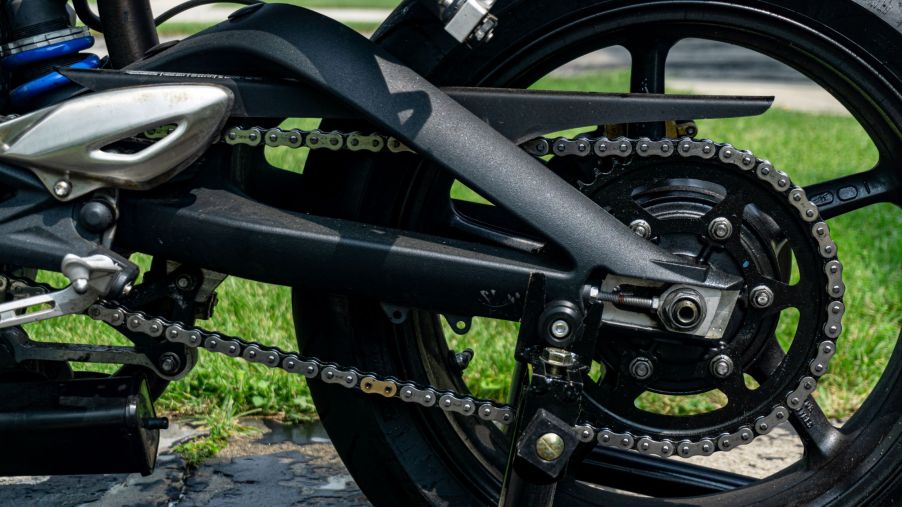
Here’s How You Can Take Care of Your Motorcycle Chain
While not every motorcycle has a chain drive, it’s perhaps the most common final drive option. And while chains have their advantages, they also require the most maintenance. However, while proper motorcycle chain care requires attention, it’s not necessarily difficult or time-consuming. It also doesn’t require any fancy maintenance equipment, just some hand tools, and a bike stand. So, if your bike’s chain needs some care, the guide below should let you know exactly what to do.
Why and how do you clean and lube a motorcycle chain?
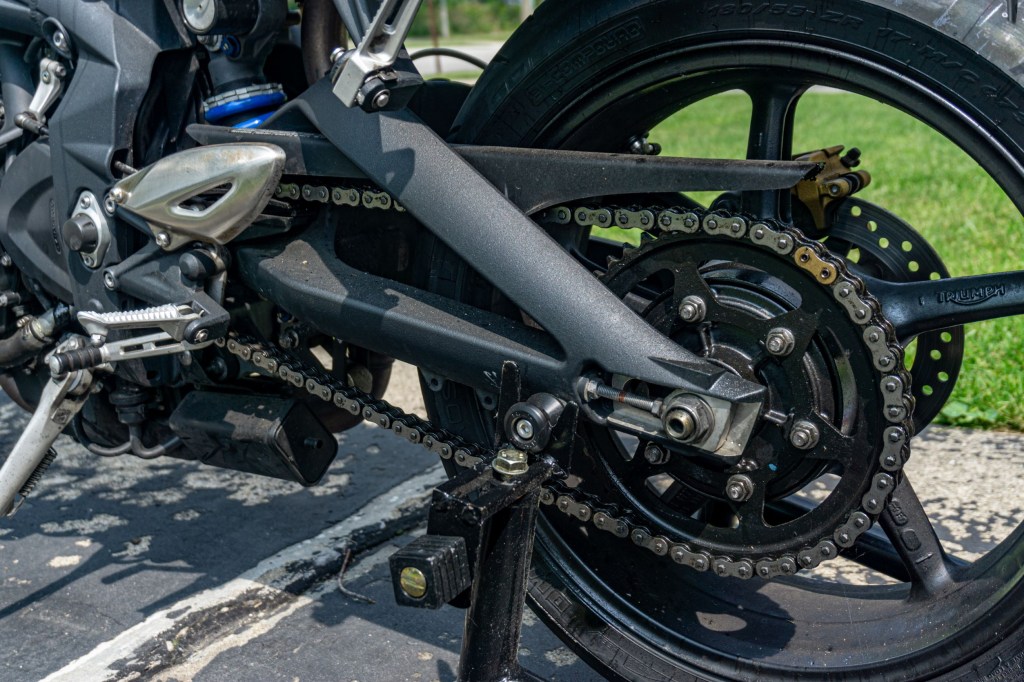
2012 Triumph Street Triple R dirty chain | Matthew Skwarczek, MotorBiscuit 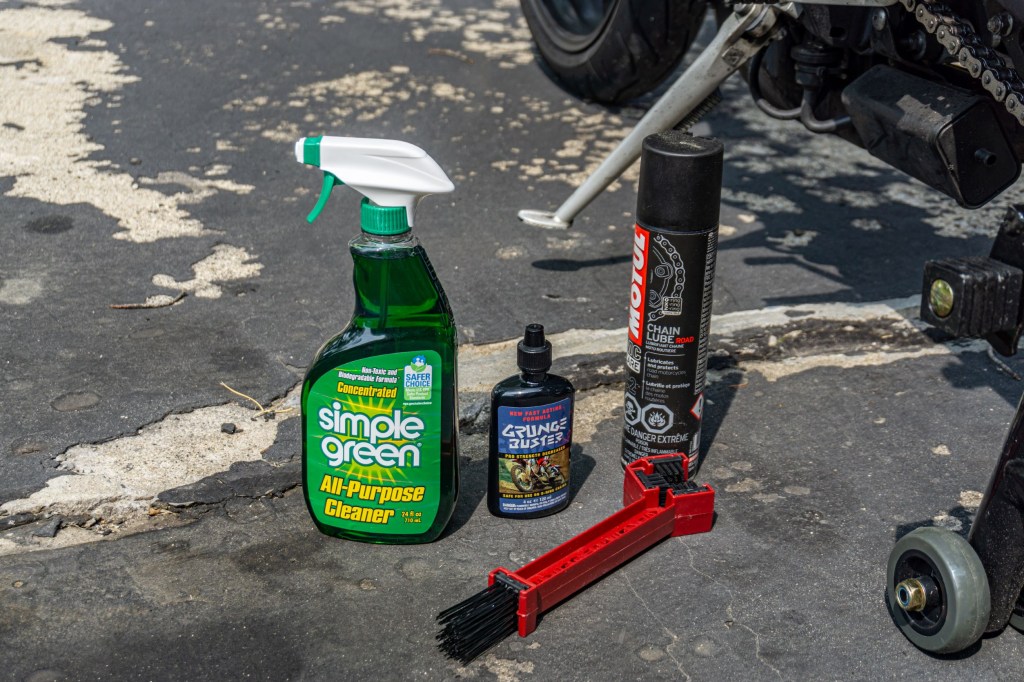
Motorcycle chain cleaning and lubrication tools | Matthew Skwarczek, MotorBiscuit 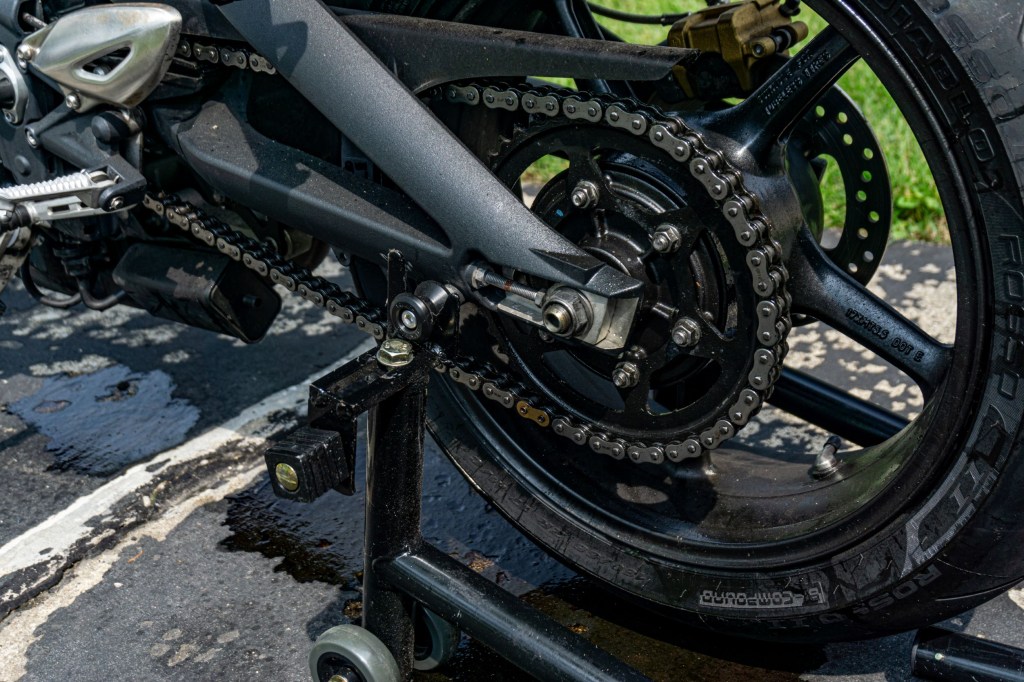
A 2012 Triumph Street Triple R with a dirty chain | Matthew Skwarczek, MotorBiscuit 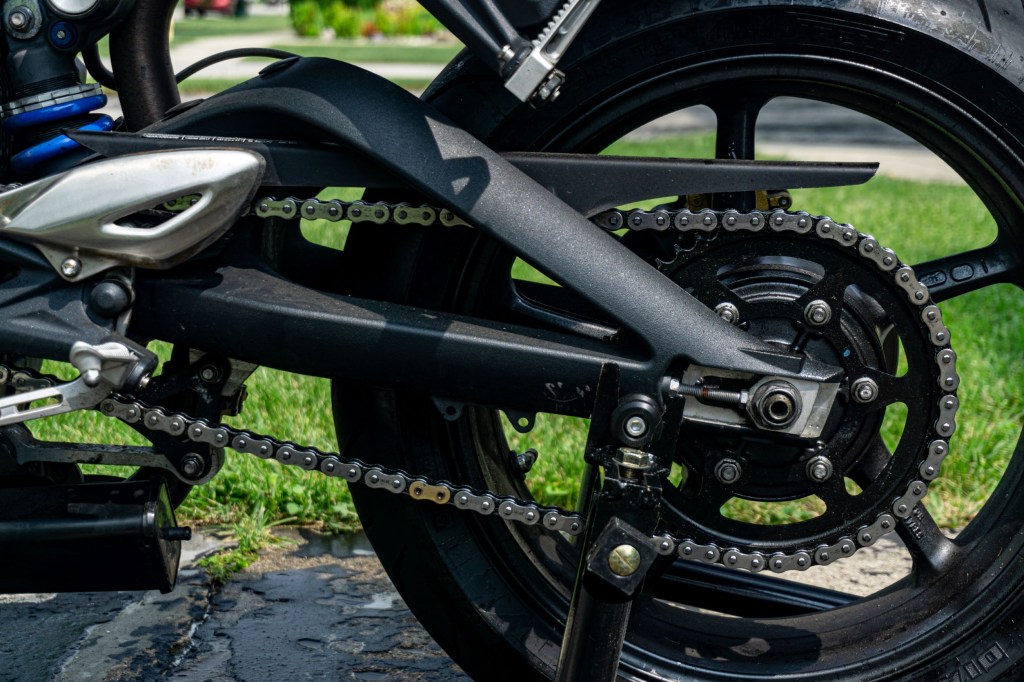
2012 Triumph Street Triple R clean motorcycle chain | Matthew Skwarczek, MotorBiscuit
The most common motorcycle chain maintenance task is cleaning and lubricating it. My 2012 Triumph Street Triple R’s chain, for example, requires lubrication every 200 miles. It doesn’t have a specific cleaning schedule, though the manual recommends cleaning the chain when it’s “especially dirty.” However, each motorcycle has a manufacturer-mandated lubrication schedule.
Given that modern motorcycle chains have internal lubrication, cleaning and lubrication them might seem pointless. But stuck-on road grime—dirt, sand, salt, etc.—causes accelerated wear and tear on the chain and sprockets, The Drive explains. And chain lube protects against rust, helps keep internal seals moist, and keeps link friction to a minimum, RideApart says. Without lube, a motorcycle chain can bunch up, sucking away power and potentially even snapping.
As critical as proper motorcycle chain cleaning and lubrication are, they’re also some of the simplest motorcycle maintenance tasks. Your owner’s manual likely states what kind of lube the manufacturer recommends for your bike. And no, WD-40 isn’t an acceptable substitute, Motorcyclist notes.
Once you have some, apply it evenly over the entire chain—while the bike is turned off—and let it soak in. My Street Triple R’s manual recommends at least an eight-hour soak, but an hour is usually good, Motorcyclist says. And once the soaking period’s over, simply wipe off the excess.
Cleaning your motorcycle chain requires a bit more elbow grease. Or rather, some cleaning solution and a brush. Commercial motorcycle chain cleaners are available, but something like Simple Green works, too. After spraying the cleaner evenly over the chain and letting it soak in, it’s scrubbing time. Then, wash the chain with a gentle stream of water.
Depending on how dirty your bike chain is, you may need to repeat this several times. And after you’re done, make sure to re-lube the chain.
Besides cleaning, your motorcycle chain also needs periodic adjustment
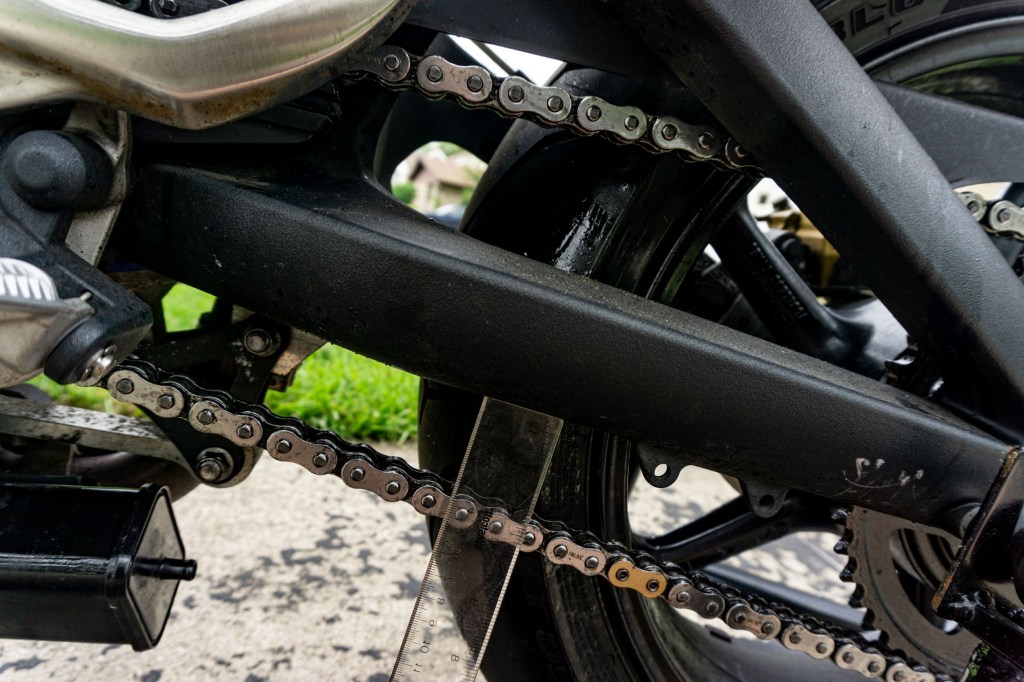
Just like a motorcycle’s throttle cable or clutch cable, its chain stretches over time. Left unchecked, a loose chain can jump off the sprocket and leave you sprawled on the ground, Motorcyclist says. It’s also noisy and inefficient. A chain that’s too tight, though, wears faster and can interfere with the motorcycle’s suspension. That’s why adjusting the slack is a key part of motorcycle chain care.
Depending on your bike’s make and model, checking its chain slack might require having both wheels on the ground. Other bikes, though, may need to be on a rear-wheel stand. That’s important to remember, as I’ll explain shortly.
But while the setup varies slightly, checking motorcycle chain slack is a fairly universal procedure. With a ruler or tape measure pressed against the lower part of the swingarm, pick a spot midway between the bike’s sprockets. Then, pull up and down on the chain, noting its highest and lowest points. The distance between those points is your chain slack. And if it falls outside of the recommended range for your motorcycle, your chain needs adjustment.
How do you adjust a motorcycle chain?
Adjusting your motorcycle chain requires a certain amount of patience. First, loosen the rear axle nut enough so the wheel can move. While the specific adjustment mechanism differs from bike to bike, it’s usually some kind of screw with a lock nut. Loosen the lock nut, then move the adjusters a little at a time to adjust the slack.
Note the plural, because there’s one adjuster on each side. And if you move one, you have to move the other by the same amount. Otherwise, your rear wheel will be out of alignment. Fortunately, the adjusters have reference marks, though they’re not always 100% accurate. That’s why I recommend using a tape measure and/or calipers to ensure the adjusters are the same length. And if you’re concerned about rear-wheel alignment, a quick way to double-check is to measure the distance from the lock nut to the swingarm pivot. If both sides’ distances match up, your alignment is good.
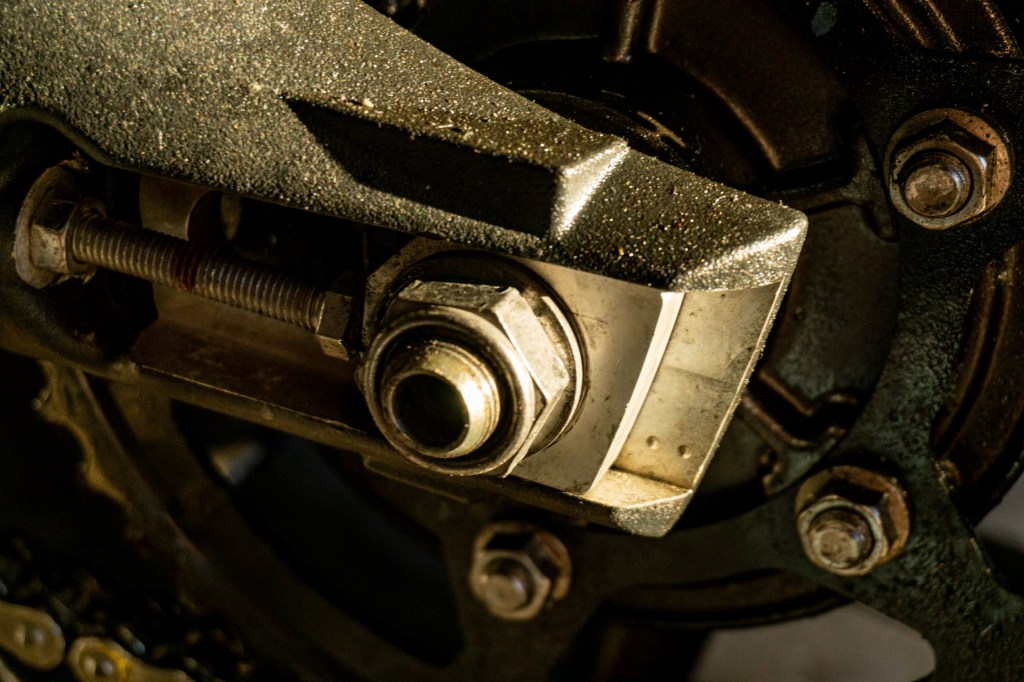
2012 Triumph Street Triple R chain adjuster and axle nut closeup | Matthew Skwarczek, MotorBiscuit 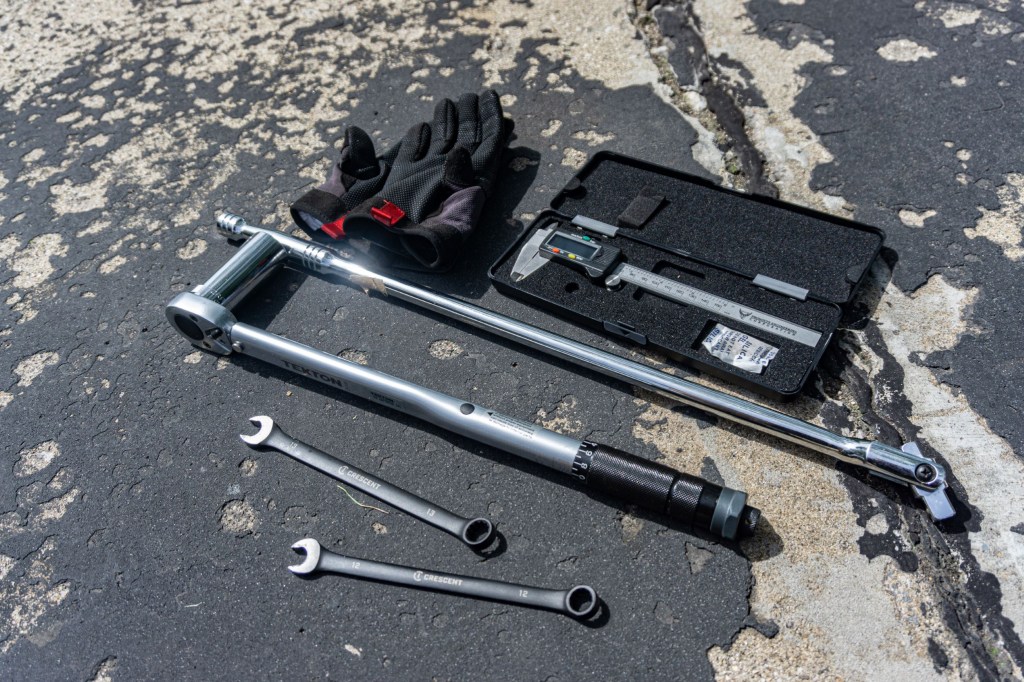
Motorcycle chain slack adjustment tools | Matthew Skwarczek, MotorBiscuit 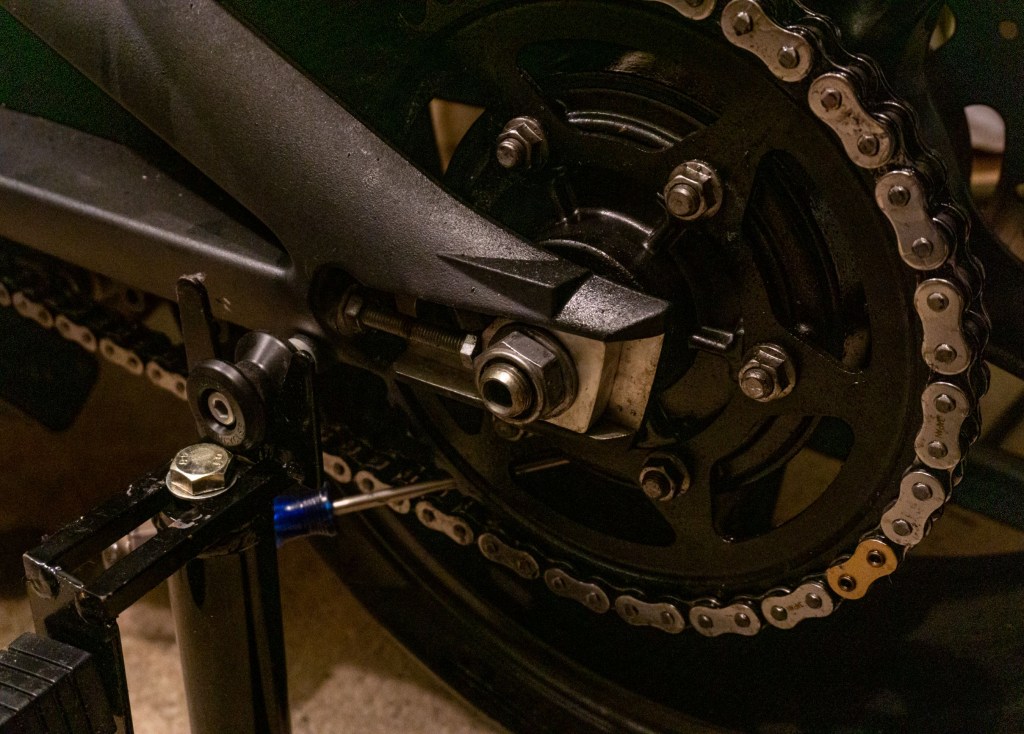
2012 Triumph Street Triple R rear sprocket with screwdriver | Matthew Skwarczek, MotorBiscuit 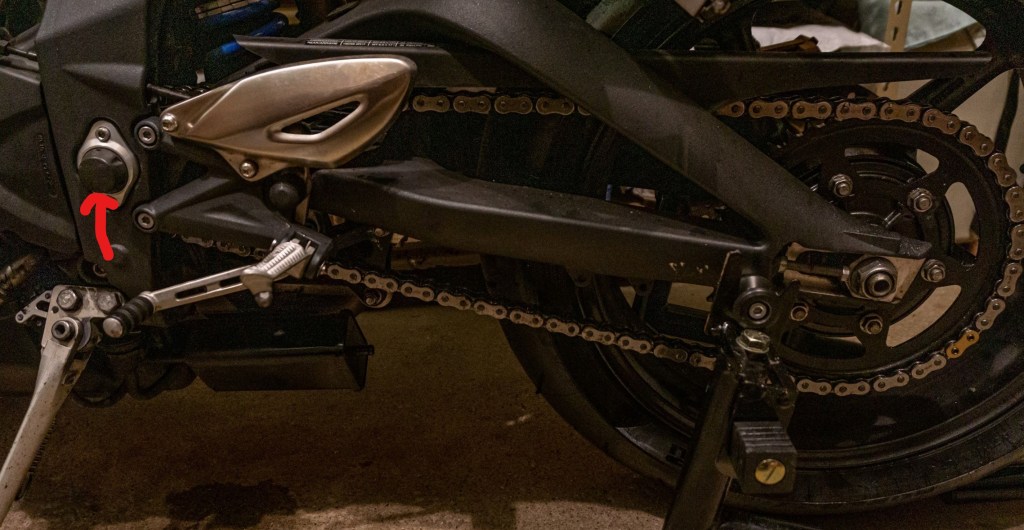
2012 Triumph Street Triple R chain and rear sprocket with the swingarm pivot indicated | Matthew Skwarczek, MotorBiscuit
Once the motorcycle chain slack is where you want it, put a rag or a screwdriver under the chain and rotate the rear wheel. This forces it securely against the adjusters, Motorcyclist explains. Then, tighten down the rear axle nut to the correct torque spec before doing the same to the adjuster locknuts. And to be on the safe side, check the slack one last time.
One thing to note is that motorcycle chains eventually need to be replaced; the sprockets, too. A sure sign of that is if your adjusters are backed out all the way. But your owner’s manual also has instructions on how to check your chain’s life. Often, it involves measuring the distance across several links with or without a weight attached. If the links have stretched too much, it’s time for a new chain. And if the sprockets are chipped, worn, or damaged, you need both new sprockets and a new chain.
What can go wrong during chain care?
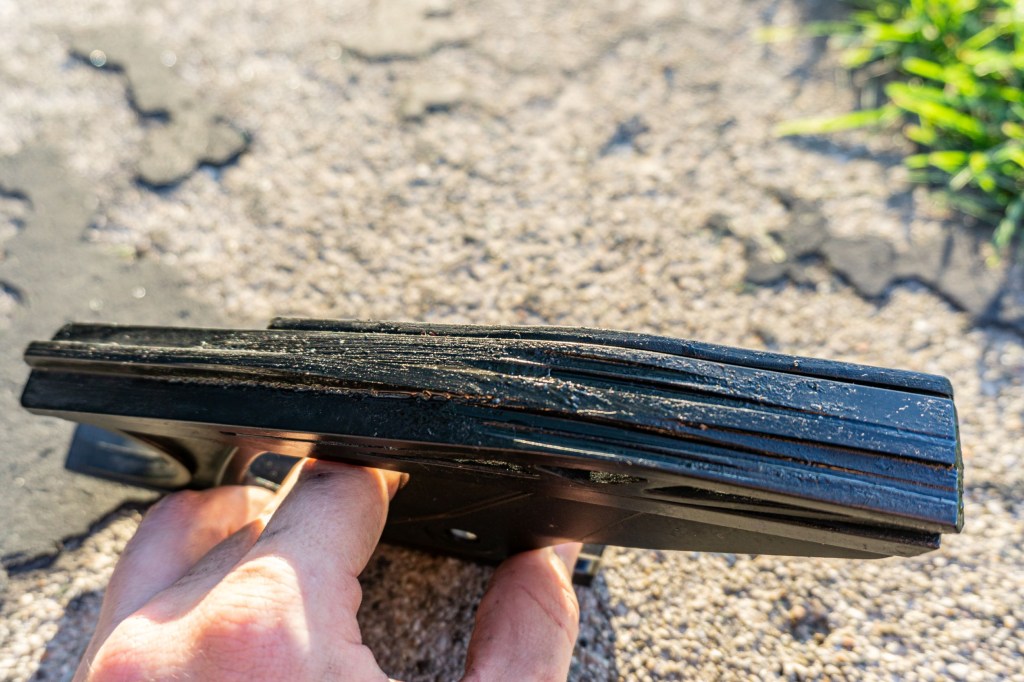
I mentioned earlier that some motorcycles require chain slack measurements with both wheels on the ground. That’s something I neglected to do when I recently adjusted my Triumph Street Triple R’s slack because I put it on a rear-wheel stand. And as a result, I started hearing a strange whirring, moaning noise once I got up to highway speeds or slowed down from them. Turns out, my chain was too tight.
However, even after readjusting my chain, the noise continued. After some wrenching and research, it turned out to have two causes. Firstly, based on owner forum posts, it appears the 675cc Street Triple R ‘prefers’ a chain slack on the looser end of Triumph’s 13-32 mm range. After loosening my motorcycle chain slightly, the noise decreased slightly.
The reason it didn’t go away, though, was because of another issue I discovered during the cleaning and adjusting process. Mounted right behind the swingarm pivot is a rubber chain slider, aka the ‘chain rubbing strip.’ It’s supposed to help the chain, well, slide smoothly, and catch excess grime. However, as you can see in the photo above, my bike’s slider has grooves cut in it from a misaligned or improperly tightened chain. The whirring noise likely stems from this damage.
However, while I had some complications during my motorcycle chain maintenance, setting the slack incorrectly is by no means uncommon. So, if you get it wrong the first time, no worries. And as for cleaning and lubricating your motorcycle chain, the only real dangers are stains and potentially getting something in your eye. But if you pay attention, it’s about as difficult as washing dishes.
Follow more updates from MotorBiscuit on our Facebook page.


